Starbucks: the Arabica challenge
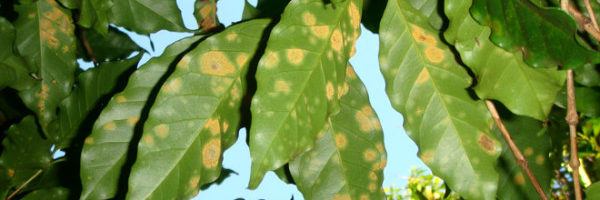
‘Farmers are seeing the effects of a changing climate, with severe hurricanes and more resistant bugs reducing crop yields. The company is now preparing for the possibility of a serious threat to global supplies.’ – Jim Hanna, Starbucks Sustainability Director, 2011 [1]
The Climate Change context
By 2016, CO2 levels in the atmosphere were 404.07ppm, the highest in 400,000 years, up approximately 7% since 2007 [2] . According to the IPCC [3], if no additional efforts are taken to mitigate the effects of climate change, CO2 concentrations may increase to 450ppm by 2030, significantly increasing global temperatures (See Exhibit 1) [3]. Such changes will have material impact for Starbucks as weather patterns and, consequently, global coffee plantation yields will be negatively affected. As the Earth warms, the interplay of shrinking glaciers, reduced snowpack, and increasingly erratic rainfall raises fears over rain shortages, severe hurricanes, mudslides and soil erosion, particularly in the core Starbucks coffee-growing areas of South and Central America [4]. In addition, warmer weather allows pests and parasites to thrive in plantations, damaging harvests [5].
Exhibit 1: Forecasted global mean temperatures [6]
What is the threat?
While some of Starbucks’s coffee supply comes from Brazil, the specialised beans from Central America’s diverse microclimates produce the blends for which Starbucks customers pay upwards of $4 [9]. If global temperatures increase as predicted, 80% of the coffee-growing land in Brazil and Central America used to grow Starbucks’s most popular type of coffee, Arabica, will become unsuitable for crop growing by 2050, and a 50% decline in coffee yield will be observed [7]. This decrease in yield may cause coffee prices to skyrocket for Starbucks, resulting in costly supply chain complications and margin erosion of products.
Is Starbucks successfully addressing the threat?
‘Addressing climate change is a big priority for Starbucks. We believe now is the time to increase our investments in solutions and strategies that address this crisis. The steps we’re taking not only address our environmental footprint – they help to ensure the supply of high-quality coffee that our customers expect from us into the future.’ – Starbucks Climate Change Responsibility, 2016 [8]
It is with mixed success that Starbucks has responded to the threat of climate change. The approach has been threefold:
(1) Starbucks successfully works with farmers to improve the ability to grow coffee in a warming climate through guidance and provision of disease-resistant beans. Starbucks helps farmers succeed in an increasingly difficult climate by offering financial support and guidance to improve the productivity of land through fertilisation, trimming trees and replacing trees [7]. Moreover, in 2013, Starbucks bought a Costa Rican coffee farm and turned it into a laboratory for testing innovative coffee-growing practices and developing disease-resistant coffee beans capable of thriving in warmer temperatures [9]. In 2014, after farmers in Chiapas, Mexico, lost 60% of their coffee production to leaf rust (See Exhibit 2), following increasing temperature and rain, Starbucks began to distribute innovative coffee plant seedlings that were rust-resistant. By 2015, Starbucks had donated 20 million of the seedlings to farmers. Despite resistance to leaf rust, the innovative seedlings had two downfalls – they were slower-growing and lower-yielding than usual beans.
Exhibit 2: Leaf rust [9]
(2) Starbucks has created more eco-conscious stores through the LEED® (Leadership in Energy and Environment Design) Initiative. Starbucks has over 1000 LEED®-certified stores in 20 countries—more than any other retailer in the world. These stores include recycled coffee grounds in table tops, low greenhouse gas emitting materials for adhesives, paints, coatings and flooring, 10% of materials extracted within 500 miles, and 45% power savings via efficient LED fixtures [8].
Exhibit 3: Starbucks LEED® certified store [8]
(3) Starbucks has less successfully endeavoured to reduce greenhouse gas footprint. Starbucks has been attempting to reduce greenhouse gas emissions by 25% in stores through doubling down on renewable energy, energy conservation, and climate adaptation and mitigation efforts [9,8,7]. However, in practice the introduction of heated food to Starbucks’s menu, which requires more refrigeration and ovens, has hampered long-term environmental goals (See Exhibit 4).
Exhibit 4: Starbucks Greenhouse Gas Footprint 2013-2015 [8]
What additional steps could Starbucks take?
- Mitigate supply risk by diversifying the global portfolio of farmers to include a greater proportion from outside South and Central America (Exhibit 5 displays the global volume of coffee growing). Suitable additions could be Ethiopia and Kenya. This would hedge against supply shocks across the distribution network, such as a disease outbreak in one specific location, allowing Starbucks to fulfil order demands and customer obligations.
- Drive further product innovation through R&D of both disease-resistant and temperature-resistant coffee beans in global Starbucks laboratories.
- Reduce greenhouse gas emissions by increasing efficiency in-store via training and incentivising baristas to adopt ‘greener’ brewing tactics that will improve machine utilisation. Similarly, reduce in-store-level emissions through greater conversion of LEED® certified stores and usage of renewable energy sources.
Exhibit 5: Global Coffee Volumes [9]
[788 words excluding exhibits]
References:
[1] “Starbucks concerned world coffee supply is threatened by climate change”, The Guardian, 2011 https://www.theguardian.com/business/2011/oct/13/starbucks-coffee-climate-change-threat
[2] NOAA, “Carbon Dioxide,” NASA website, http://climate.nasa.gov/vital-signs/carbon-dioxide/, accessed October 2016.
[3] 28 Summary for Policymakers, In: Climate Change 2014, Mitigation of Climate Change,” Intergovernmental Panel on Climate
Change, 2014, p. 9, https://www.ipcc.ch/pdf/assessment-report/ar5/wg3/ipcc_wg3_ar5_summary-for-policymakers.pdf, accessed August 201
[4] “Water and Food Security,” Food and Agriculture Organization of the United Nations, http://www.fao.org/docrep/x0262e/x0262e01.htm, accessed October 2016
[5] 72 “Agriculture and Food Supply,” accessed October 2016
[6] “Climate Change 2014: Impacts, Adaptation, and Vulnerability Top-Level Findings,” Intergovernmental Panel on Climate Change, 2014, pp. 3, http://www.ipcc.ch/report/ar5/wg2/docs/WGIIAR5_SPM_Top_Level_Findings.pdf,
Accessed October 2016
[7] “Starbucks Responds to Climate Change, with Mixed Results”, Technology Review, 2016 https://www.technologyreview.com/s/601404/starbucks-responds-to-climate-change-with-mixed-results/
[8] http://www.starbucks.ph/responsibility/environment/climate-change
[9] “To Stop the Coffee Apocalypse, Starbucks Buys a Farm”, Bloomberg, 2014
http://www.bloomberg.com/news/articles/2014-02-13/to-stop-the-coffee-apocalypse-starbucks-buys-a-farm




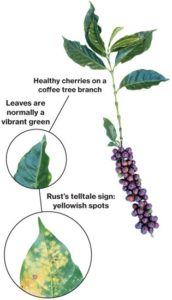
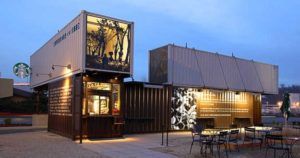
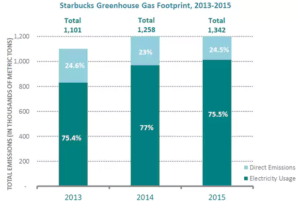
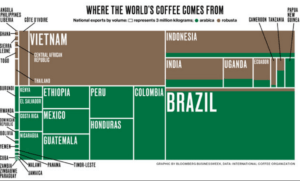
What I like the most about Starbucks is that it´s one of the very few companies actually getting involved and working into long-term solutions for the coffee industry, not only into short-term quick fixes. I have seen several cases in which companies are setting long-term contracts, hedging trading of coffee futures, buying a higher quantity of coffee to minimize lower-yield risks and so on, however, all these initiatives are limited if temperature keeps increasing.
As a heavy coffee drinker myself (average of 4 espressos per day), the impact of climate changes in the coffee industry really concerns me. I have personally invested some time researching long-term possible solutions to minimize the rising temperature´s negative effect and I´d like to add a few points to your recommendation:
1) Mitigate supply risk by diversifying producers
It´s a good solution, indeed. I would also add Indonesia and India in the list, the 4th and 6th largest Arabica producers in the world. However, this is still a short-term fix, as basically all the regions in the world are being impacted by global warming and we can expect lower yield in pretty much all these countries by 2050[i]. Therefore, I´d also implement this initiative, as the article suggest, but would have in mind that this solution alone is not going to solve any longstanding issue.
2) Drive further product innovation through R&D
This, in my opinion, is what will either solve the big picture coffee industry issue or not. I like the strategy of distributing more resistant coffee beans to producers to help them achieve high-yield crops, as ultimately Starbucks depend on these farmers.
I´d actually double down in this strategy, perhaps partnering with other entities from the sector – for instance, wholesalers and big producers, to increase investment. I´d also invest a part of the budget in developing Robusta beans, as they are more heat and pest resistant. Although Robusta beans don´t have a rich flavour and aroma as Arabica beans do, Robusta are cheaper and easier to produce.
[i] http://fairtrade.com.au/~/media/fairtrade%20australasia/files/resources%20for%20pages%20-%20reports%20standards%20and%20policies/tci_a_brewing_storm_final_24082016_web.pdf
As someone who also wrote about Starbucks, I really like how you incorporated the “Where the World’s Coffee Comes From” graphic as I found it hard to suggest where else Starbucks should source their coffee beans. I too suggested that Starbucks move away from coffee bean farmers located in South America by the equator. Hedging against South American supply shocks such as disease outbreak by adding Ethiopia and Kenya suppliers would be a really wise move on Starbucks’ part. However, after reading VCG’s response, I really like the idea of Starbucks developing Robusta bean sources. Robusta beans are more heat and pest resistant. They also come from different parts of the world and are not centrally located in South America. It would also be an interesting for Starbucks to research the affects either generically altering or micro-treating coffee beans to make them more resistant to heat and pests.
It’s great to hear that Starbucks is coming to the forefront and developing innovative solutions to address climate change. The company’s efforts to partner with farmers and test coffee-growing practices will likely have a long-term, sustainable impact in the future. However, I also think there are quick wins the company can employ within its retail locations. For example, I recently read an article that Starbucks has been using misleading recycling claims, and that cups are actually not recyclable. The store likely uses billions of cups per year, and the company should work to make cups that contain recycled content. Additionally, the company should also encourage greater use of consumers bringing their own reusable mugs to retail locations.
I was surprised to learn that Starbucks has effectively moved up the supply chain with substantial R&D investment in innovative new coffee beans. All of the retail store changes are admirable but also predictable. I was also interested to read above in SHK’s comment that Starbucks’ cups are not truly recyclable. It’s really disheartening that they care more about the look / texture of their “fashionable” cups rather than they do about the ability to recycle them. In addition to improving the recyclability of the cups, I agree with the other additional steps that Starbucks shield be taking. They should, of course, continue making in store changes first and foremost. With almost 25K stores worldwide, they have a massive brick and mortar footprint with which they can continue making positive eco-friendly changes.